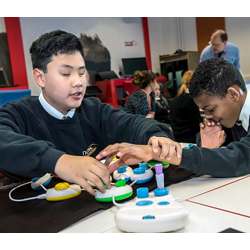
Andreas Stefik knows a thing or two about how inaccessible the world of technology can be to people with disabilities. An associate professor of computer science at the University of Nevada, Las Vegas, Stefik has spent over a decade working on tools to make it easier for the disabled to write code.
Stefik's research deals with topics related to computer science and accessibility. In 2011, he introduced the programming language Quorum, which he invented and designed to be easy to learn and use, and to be accessible to the blind. The program was originally part of the development environment Sodbeans, a NetBeans derivative, but was a standalone compiler by 2012.
Before Quorum was created, a lot of computer science and programmer languages were using increasingly visual content. Quorum is not just visual, but also auditory, so it can be used more easily be used by the blind or visually impaired. The language itself is simpler, too, so it's easier to work with and understand.
In 2016, the White House named Stefik one of its Champions of Change for his work making computer science education more accessible to the disabled, and for making it easier for people, including those with disabilities, to write computer code.
Today, Stefik says, computer programming tools and education still need to become significantly more accessible for people with disabilities.
I asked Stefik about the obstacles faced by coders with disabilities today—and what must be done to address them.
What are the biggest obstacles today for people with disabilities who want to write software?
A vast number of computer science tools just aren't accessible. This is not just an issue in K-12 education; it extends all the way through professional practice. Major development environments (e.g., Eclipse, NetBeans, Visual Studio) sometimes do alright on this issue—and sometimes not—depending on the version and language they were developed in. In fact, some programming languages do not support accessibility well, which makes technologies built on top of them equally inaccessible.
The curriculum has challenges, too, in terms of getting students to professional practice. To my knowledge, none of the Computer Science Principles (CSP) curriculum certified by the College Board is fully accessible. Worse, if you are blind, there are a number of serious problems with the CSP exam. For example, students cannot always get materials in the version of Braille that they know.
What do you see as the most promising solutions to these obstacles?
First, we need to fix the tools. The programming languages themselves need to be accessible. This includes languages that have visualization (e.g., blocks) and the environments they are embedded in. This has to happen first because no matter how clever the curriculum is, how fun the activities are, or how neat and inspiring the work is, if the tools are not accessible then a student really cannot equally participate.
Are technology companies sympathetic to the challenges people with disabilities face when it comes to modern technology?
Many tech companies are massively better at this than they were a decade or two ago—and I really mean that. For example, I really have to applaud Microsoft's diversity efforts. Andy Begel and his colleagues did work on neurodiverse populations that made me truly joyful when I read it. They've made progress on a lot of fronts, but especially in understanding how that crowd varies, which seems to be impacting groups across Microsoft.
Of course, not every company is making progress, but it feels like good positive momentum to me.
What do you wish people in technology understood better about programmers with disabilities?
Personally, I wish people in tech were actually trained on how accessibility systems work on a technical level. Most of the time, when we see problems in accessibility code, it is not some nefarious evil plan to exclude people. On the contrary, I think most people care a lot and would prefer to be inclusive. But, accessibility technology is not taught in schools, so the learning time can be significant.
Do you have any thoughts on how the U.S. education system should change to better address these issues?
In K-12, my view is that any class in computer science should, by law, be accessible to students with disabilities. I know some of my colleagues in the field might disagree or feel like my language is too strong by saying this, but I feel like excluding students with disabilities is a violation of their civil rights.
States can, and should, adjust their laws, like Nevada did with SB 200, to make this clear. I was proud to be a part of the process of getting some language in that bill. I hope other states can make similar progress.
Accessibility also needs to be put into the college education system. Students should not leave an undergraduate education and not know how to make an application accessible on various platforms. Students should not just learn what accessibility is, but how to code their ideas up. I think even a basic introduction would do wonders for industry over time.
Logan Kugler is a freelance technology writer based in Tampa, FL. He has written for over 60 major publications.



Join the Discussion (0)
Become a Member or Sign In to Post a Comment